Study on the Combined Effect of Multiple Passive Energy-Saving Methods for Rural Houses with Cold Alleys
Abstract
1. Introduction
1.1. Motivation
1.2. Previous Studies
1.3. Scientific Originality
1.4. Targets of This Research
- By comparing the effects before and after adding thermal insulation walls in traditional residential buildings, we estimated the annual cooling load reduction from using thermal insulation walls in summer.
- The cooling effects of a base case and of a building using the passive system were examined without considering the WHR, aiming to calculate the cooling efficiency inside the building, thermal equilibrium temperature, and reduction of the cooling load for the entire building throughout the year.
- The cooling effects of the new system with and without WHR were compared, in addition to the room cooling rate, thermal equilibrium temperature, and annual cooling load reduction for the entire building.
- Based on comparing the heating effects of a courtyard with or without a glass roof in winter, we estimated the time required for a patio to meet the required heating conditions and reduce the total heating load throughout the year.
- The appropriate utilization time for the new passive system over a year was calculated.
- According to a local comfort temperature standard, the annual time required to meet the comfort temperature requirement for the base case was estimated, and the annual times required to meet the comfort temperature standard after using the new system with and without WHR were compared.
2. Methodology
2.1. Investigation Study
2.1.1. Geographical Location and Weather Conditions
2.1.2. Case Study Information
- Field investigation: The different forms of traditional houses in the village were collected and sorted, and representative buildings related to the study were selected.
- Measurement of related data: The data of these traditional houses were measured, including the size of the building, positions of doors and windows, indoor and outdoor temperatures and wind speed, outer surface temperature of the building, and angle between the dominant wind direction and building.
- Summarizing and organizing the data: After the measured data were unified and integrated, the most representative data were used for the case study.
- Problem confirmation: It was found that the temperature in the cold alley around the building was generally lower than the normal outdoor temperature. After analyzing the measured data of the case study, it was found that the indoor thermal environment and ventilation efficiency in the building required improvement.
- Countermeasures: After analyzing and researching a cold road in the village, we considered how to use the cold air in the cold alley to cool the building and improve the ventilation.
2.2. Analysis of the Cold Air Storage Capacity in Cold Alleys
2.2.1. Sunshine and Temperature Analysis in Cold Alleys
2.2.2. Ventilation in the Cold Alley
2.3. Transformation of the Original Case
- Introduction of basic study case, which will be compared with the reconstructed building.
- Analysis of the operation principle of heat transfer of the heat insulation wall in summer. It is mainly used to introduce the cold air in the cold alley into the room and slow down the heat transfer.
- Introduction of the operating principles of the new system when the wall heat radiation is considered and when the wall heat radiation is not considered.
- After adding a glass roof above the patio in winter, analysis of the heat storage capacity of the courtyard and the operating principle of heat transfer to the room.
2.3.1. Natural Ventilation Cooling (Base Case)
2.3.2. Summer Air Insulation Wall
2.3.3. Using Cold Alleys to Cool Buildings in Summer (without Wall Heat Radiation (WHR))
2.3.4. Using Cold Alleys to Cool Buildings in Summer (with WHR)
2.3.5. Installation of the Glass Roof in Winter
2.4. Simulation Steps and Related Software
2.4.1. Model Building and Grid Setting
2.4.2. Boundary Condition
2.4.3. Governing Equation
2.4.4. Large Eddy Simulation (LES)
2.4.5. Calculation of the Radiation and Convection Heat Transfer Coefficient
2.4.6. Surface to Surface (S2S) Heat Radiation Equation
2.4.7. Calculation Program
2.4.8. CFD and Energy Plus Co-Simulation Simulation
- Fully internally coupled, in which the nodal model and CFD model equations are solved iteratively together.
- Iterative external coupling, in which the nodal model and the CFD model equations are solved separately, and the variables are exchanged through an iterative process until the convergence state is reached.
- Progressive replacement external coupling, in which the set of variables is exchanged after each model reaches the state of convergence at each time step.
3. Results and Discussion
3.1. Comparison of the Air Insulation Wall and the Basic Case
3.2. Passive Cooling of the New System and Base Case
3.2.1. Comparison of Passive Cooling of the New System with That of the Base Case
3.2.2. Cooling Time and Thermal Equilibrium Temperature of the New System with and without WHR
3.3. Comparison of the Natural Ventilation of the New System and the Base Case
3.4. Patio Glass Roof in Winter
3.5. Cooling Load Reduction by the Air Insulation Wall
3.6. Comparison of Whether the New System with WHR Reduces the Cooling Load in Summer
3.7. Patio Glass Roof Reduces the Heating Load in Winter
3.8. Suitable Time for the New System throughout the Year
3.9. Time Suitable for the Building to Meet the Thermal Comfort Temperature after Using the New System
4. Conclusions and Prospects
4.1. Conclusions
- After the building used the new system, the total cooling load, as reduced by the air insulation wall throughout the year, was 1133.7 kWh. After cooling through the cold alley without WHR, the cooling efficiency of the new system was 3.61 °C/h, and the total cooling load in the building in one year was reduced by 55,417.33 kWh. With WHR, the cooling efficiency of the new system was 1.03 °C/h, and the total cooling load was reduced by 28,537.57 kWh. This shows that the WHR has a negligible effect on the indoor temperature.
- Adding a glass roof above the patio can increase its heat storage capacity. The patio completed heat storage after 33.3 min, and then began heating the indoor areas. After using the glass roof for a year, the total heating load of the courtyard for the building was 54,537.78 kWh.
- After the building used the new system without WHR, the time it took for the room to reach the thermal equilibrium temperature was 1.66 h, and the thermal equilibrium temperature was 28 °C. With WHR, the time for the room to reach the thermal equilibrium temperature was 1.94 h, and the temperature was 32 °C. The ventilation time was shortened from the original 2.22 h to 4 min; this also shows that the indoor heat transfer rate of the room has nothing to do with the ventilation rate.
- The temperature range for thermal comfort in Shuhe is 18–25 °C. The total time in the base case meeting the thermal comfort temperature over a year was 2349 h, accounting for 26.81% of the total time of the year. After using the new system without WHR, the annual time meeting the thermal comfort temperature was 2455 h, accounting for 28.02% of the annual time, and an increase of 106 h relative to the base case. With WHR, the annual time meeting the thermal comfort temperature in a year was 2420 h, accounting for 27.62% of the year, an increase of 71 h relative to the base case. The location of the room affects the temperature in the room, and the thermal comfort time of all rooms decreases after considering the WHR.
4.2. Prospects
- This study was mainly aimed at completely passive cooling. Owing to the limitations of the air temperature in the cold alley, the room temperature did not reach a comfortable range. In the future, it will be necessary to combine passive cooling with air conditioning to make the room reach a comfortable temperature and calculate the energy consumption of the air conditioning so as to save the energy used by air conditioning to the greatest extent.
- This study mainly used a patio with a heat storage function as a constant temperature heat source but did not describe its specific impact on the room, such as the specific value of the temperature increase in the room. In winter, the factors affecting indoor temperature are not limited to those of the patio; thus, a comprehensive analysis of other factors should be conducted.
- The humidity of the air in the cold alley is relatively high and will have a greater impact on indoor humidity after being introduced into the room. In future research, it will be necessary to consider air humidity as an important reference factor for measuring comfort.
Author Contributions
Funding
Institutional Review Board Statement
Informed Consent Statement
Data Availability Statement
Acknowledgments
Conflicts of Interest
References
- Agencia Internacional de la Energía. World Energy Outlook 2017; International Energy Agency together Security Sustainability 2017; OECD: London, UK, 2017. [Google Scholar]
- U.S. EIA. Annual Energy Outlook 2018; DOE: Washington, DC, USA, 2018. [Google Scholar]
- IEA Online Data Services. Available online: https://www.iea.org/subscribe-to-data-services/world-energybalances-and-statistics (accessed on 15 July 2020).
- IEA. World Energy Balances 2019 Database Documentation (2019); IEA: Paris, France, 2019. [Google Scholar]
- Liu, C.; Xu, W.; Li, A.; Sun, D.; Huo, H. Energy balance evaluation and optimization of photovoltaic systems for zero energy residential buildings in different climate zones of China. J. Clean. Prod. 2019, 235, 1202–1215. [Google Scholar] [CrossRef]
- Liu, Z.; Liu, Y.; He, B.-J.; Xu, W.; Jin, G.; Zhang, X. Application and suitability analysis of the key technologies in nearly zero energy buildings in China. Renew. Sustain. Energy Rev. 2019, 101, 329–345. [Google Scholar] [CrossRef]
- Hu, W.; Fan, Y. International Energy Agency Transition to Sustainable Buildings: Strategies and Opportunities to 2050; OECD/IEA: Paris, France, 2013. [Google Scholar]
- Hu, W.; Fan, Y. City Size and Energy Conservation: Do Large Cities in China Consume More Energy? Energy Econ. 2020, 92, 104943. [Google Scholar] [CrossRef]
- World Bank Staff Estimates Based on the United Nations Population Division’s World Urbanization Prospects: 2018 Revision; The World Bank, United Nations: New York, NY, USA, 2018.
- Tahsildoost, M.; Zomorodian, Z. Energy, carbon, and cost analysis of rural housing retrofit in different climates. J. Build. Eng. 2020, 30, 101277. [Google Scholar] [CrossRef]
- Yawale, S.K.; Hanaoka, T.; Kapshe, M. Development of energy balance table for rural and urban households and evaluation of energy consumption in Indian states. Renew. Sustain. Energy Rev. 2021, 136, 110392. [Google Scholar] [CrossRef]
- Twumasi, M.A.; Jiang, Y.; Ameyaw, B.; Danquah, F.O.; Acheampong, M.O. The impact of credit accessibility on rural households clean cooking energy consumption: The case of Ghana. Energy Rep. 2020, 6, 974–983. [Google Scholar] [CrossRef]
- Jiang, L.; Xue, B.; Xing, R.; Chen, X.; Song, L.; Wang, Y.; Coffman, D.; Mi, Z. Rural household energy consumption of farmers and herders in the Qinghai-Tibet Plateau. Energy 2020, 192, 116649. [Google Scholar] [CrossRef]
- Wu, S.; Zheng, X.; You, C.; Wei, C. Household energy consumption in rural China: Historical development, present pattern and policy implication. J. Clean. Prod. 2019, 211, 981–991. [Google Scholar] [CrossRef]
- Temudo, M.P.; Cabral, A.I.; Talhinhas, P. Urban and rural household energy consumption and deforestation patterns in Zaire province, Northern Angola: A landscape approach. Appl. Geogr. 2020, 119, 102207. [Google Scholar] [CrossRef]
- Hao, Y.; Zhu, L.; Ye, M. The dynamic relationship between energy consumption, investment and economic growth in China’s rural area: New evidence based on provincial panel data. Energy 2018, 154, 374–382. [Google Scholar] [CrossRef]
- Niu, S.; Li, Z.; Qiu, X.; Dai, R.; Wang, X.; Qiang, W.; Hong, Z. Measurement of effective energy consumption in China’s rural household sector and policy implication. Energy Policy 2019, 128, 553–564. [Google Scholar] [CrossRef]
- Qiu, H.; Yan, J.; Lei, Z.; Sun, D. Rising wages and energy consumption transition in rural China. Energy Policy 2018, 119, 545–553. [Google Scholar] [CrossRef]
- Pozas, B.M.; Gamero, I.A.; Domínguez, A.S.; De Castro, P.B.G. A methodology to improve energy efficiency and comfort conditions with low-cost ICTs in rural public buildings. Sustain. Cities Soc. 2020, 60, 102156. [Google Scholar] [CrossRef]
- He, B.J.; Yang, L.; Ye, M. Building energy efficiency in China rural areas: Situation, drawbacks, challenges, corre-sponding measures and policies. Sustain. Cities Soc. 2014, 11, 7–15. [Google Scholar] [CrossRef]
- Chakraborti, S.; Mondol, J.D.; Smyth, M.; Zacharopoulos, A.; Pugsley, A. Energy consumption levels and technical approaches for supporting development of alternative energy technologies for rural sectors of developing countries. Renew. Sustain. Energy Rev. 2018, 97, 90–102. [Google Scholar]
- Wang, W.; Yuan, M.; Li, Y.-Z.; Li, C. Numerical investigation on the impact of an on-top sunspace passive heating approach for typical rural buildings in northern China. Sol. Energy 2019, 186, 300–310. [Google Scholar] [CrossRef]
- Boccalatte, A.; Fossa, M.; Gaillard, L.; Menezo, C. Microclimate and urban morphology effects on building energy demand in different European cities. Energy Build. 2020, 224, 110129. [Google Scholar] [CrossRef]
- Li, M.; Jin, T.; Liu, S.; Zhou, S. The cost of clean energy transition in rural China: Evidence based on marginal treatment effects. Energy Econ. 2021, 97, 105167. [Google Scholar] [CrossRef]
- Liu, Y.W.; Feng, W. Integrating passive cooling and solar techniques into the existing building in South China. In Proceedings of the 4th International Conference on Technology of Architecture and Structure (ICTAS 2011), Xi’an, China, 22–24 September 2011; pp. 368–373. [Google Scholar]
- Rosti, B.; Omidvar, A.; Monghasemi, N. Optimum position and distribution of insulation layers for exterior walls of a building conditioned by earth-air heat exchanger. Appl. Therm. Eng. 2019, 163, 114362. [Google Scholar] [CrossRef]
- Chi, F.; Xu, L.; Peng, C. Integration of completely passive cooling and heating systems with daylighting function into courtyard building towards energy saving. Appl. Energy 2020, 266, 114865. [Google Scholar] [CrossRef]
- Fiaschi, D.; Bertolli, A. Design and energy analysis of solar roofs: A viable solution with esthetic appeal to collect solar heat. Renew Energy 2012, 46, 60–71. [Google Scholar] [CrossRef]
- Kishore, R.A.; Bianchi, M.V.; Booten, C.; Vidal, J.; Jackson, R. Enhancing building energy performance by effectively using phase change material and dynamic insulation in walls. Appl. Energy 2021, 283, 116306. [Google Scholar] [CrossRef]
- Zhang, L.; Liu, Z.; Hou, C.; Hou, J.; Wei, D.; Hou, Y. Optimization analysis of thermal insulation layer attributes of building envelope exterior wall based on DeST and life cycle economic evaluation. Case Stud. Therm. Eng. 2019, 14, 100410. [Google Scholar] [CrossRef]
- Wang, J.; Du, Q.; Zhang, C.; Xu, X.; Gang, W. Mechanism and preliminary performance analysis of exhaust air insulation for building envelope wall. Energy Build. 2018, 173, 516–529. [Google Scholar] [CrossRef]
- Mahlia, T.M.I.; Iqbal, A. Cost benefits analysis and emission reductions of optimum thickness and air gaps for selected in-sulation materials for building walls in Maldives. Energy 2010, 35, 2242–2250. [Google Scholar] [CrossRef]
- Chandel, S.; Sarkar, A. Performance assessment of a passive solar building for thermal comfort and energy saving in a hilly terrain of India. Energy Build. 2015, 86, 873–885. [Google Scholar] [CrossRef]
- Bhamare, D.K.; Rathod, M.K.; Banerjee, J. Passive cooling techniques for building and their applica-bility in different climatic zones—The state of art. Energy Build. 2019, 198, 467–490. [Google Scholar] [CrossRef]
- Serageldin, A.A.; Abdeen, A.; Ahmed, M.M.; Radwan, A.; Shmroukh, A.N.; Ookawara, S. Solar chimney combined with earth to-air heat exchanger for passive cooling of residential buildings in hot areas. Sol. Energy 2020, 206, 145–162. [Google Scholar] [CrossRef]
- Vaseghi, M.; Fazel, M.; Ekhlassi, A. Numerical investigation of solar radiation effect on passive and active heating and cooling system of a concept museum building. Therm. Sci. Eng. Prog. 2020, 19, 100582. [Google Scholar] [CrossRef]
- Sivaram, P.; Mande, A.B.; Premalatha, M.; Arunagiri, A. Investigation on a building-integrated passive solar energy technology for air ventilation, clean water and power. Energy Convers. Manag. 2020, 211, 112739. [Google Scholar] [CrossRef]
- Layeni, A.T.; Waheed, M.A.; Adewumi, B.A.; Bolaji, B.O.; Nwaokocha, C.N.; Giwa, S.O. Computational modelling and simulation of the feasibility of a novel dual purpose solar chimney for power generation and passive ventilation in buildings. Sci. Afr. 2020, 8, e00298. [Google Scholar] [CrossRef]
- Zhang, R.; Nie, Y.; Lam, K.P.; Biegler, L.T. Dynamic optimization based integrated operation strategy design for passive cooling ventilation and active building air conditioning. Energy Build. 2014, 85, 126–135. [Google Scholar] [CrossRef]
- Yeh, S.-C.; Whang, A.J.-W.; Hsiao, H.-C.; Hu, X.-D.; Chen, Y.-Y. Distribution of Emerged Energy for Daylight Illuminate on Prismatic Elements. J. Sol. Energy Eng. 2011, 133, 021007. [Google Scholar] [CrossRef]
- Mao, Q.; Yang, M. Experimental and numerical investigation on heat transfer performance of a solar double-slope hollow glazed roof. Appl. Therm. Eng. 2020, 180, 115832. [Google Scholar] [CrossRef]
- Yi, Z.; Lv, Y.; Xu, D.; Xu, J.; Qian, H.; Zhao, D.; Yang, R. Energy saving analysis of a transparent radiative cooling film for buildings with roof glazing. Energy Built Environ. 2021, 2, 214–222. [Google Scholar] [CrossRef]
- Li, D.; Wu, Y.; Zhang, G.; Arıcı, M.; Liu, C.; Wang, F. Influence of glazed roof containing phase change material on indoor thermal environment and energy consumption. Appl. Energy 2018, 222, 343–350. [Google Scholar] [CrossRef]
- Pourrahmani, H.; Moghimi, M. Exergoeconomic analysis and multi-objective optimization of a novel continuous solar-driven hydrogen production system assisted by phase change material thermal storage system. Energy 2019, 189, 116170. [Google Scholar] [CrossRef]
- Muselli, M. Passive cooling for air-conditioning energy savings with new radiative low-cost coatings. Energy Build. 2010, 42, 945–954. [Google Scholar] [CrossRef]
- Zheng, C.; Wu, P.; Costanzo, V.; Wang, Y.; Yang, X. Establishment and Verification of Solar Radiation Calculation Model of Glass Daylighting Roof in Hot Summer and Warm Winter Zone in China. Procedia Eng. 2017, 205, 2903–2909. [Google Scholar] [CrossRef]
- Bruno, R.; Bevilacqua, P.; Arcuri, N. Green roofs as passive system to moderate building cooling requirements and UHI effects: Assessments by means of experimental data. In Woodhead Publishing Series in Civil and Structural Engineering, Eco-efficient Materials for Reducing Cooling Needs in Buildings and Construction; Pacheco-Torgal, F., Czarnecki, L., Laura Pisello, A., Cabeza, L.F., Granqvist, C.-G., Eds.; Woodhead Publishing: Sawston, UK, 2021; pp. 205–245. [Google Scholar] [CrossRef]
- Prieto, A.; Knaack, U.; Auer, T.; Klein, T. Passive cooling & climate responsive façade design: Ex-ploring the limits of passive cooling strategies to improve the performance of commercial buildings in warm climates. Energy Build. 2018, 175, 30–47. [Google Scholar]
- Yao, X.; Dewancker, B.; Guo, Y.; Han, S.; Xu, J. Study on Passive Ventilation and Cooling Strategies for Cold Lanes and Courtyard Houses—A Case Study of Rural Traditional Village in Shaanxi, China. Sustainability 2020, 12, 8687. [Google Scholar] [CrossRef]
- Staveckis, A.; Borodinecs, A. Impact of impinging jet ventilation on thermal comfort and indoor air quality in office buildings. Energy Build. 2021, 235, 110738. [Google Scholar] [CrossRef]
- Zhang, X.; Weerasuriya, A.U.; Tse, K.T. CFD simulation of natural ventilation of a generic building in various incident wind directions: Comparison of turbulence modelling, evaluation methods, and ventilation mechanisms. Energy Build. 2020, 229, 110516. [Google Scholar] [CrossRef]
- Blocken, B. LES over RANS in building simulation for outdoor and indoor applications: A foregone conclusion? Build. Simul. 2018, 11, 821–870. [Google Scholar] [CrossRef]
- Zhang, M.; Li, R.; Wu, Y.; Wang, L.; Song, G.; Li, J. Numerical study of the convective heat transfer coefficient of the hand and the effect of wind. Build. Environ. 2021, 188, 107482. [Google Scholar] [CrossRef]
- Yang, J.-H.; Kato, S.; Seo, J. Evaluation of the Convective Heat Transfer Coefficient of the Human Body Using the Wind Tunnel and Thermal Manikin. J. Asian Arch. Build. Eng. 2009, 8, 563–569. [Google Scholar] [CrossRef]
- Gao, S.; Ooka, R.; Oh, W. Formulation of human body heat transfer coefficient under various ambient temperature, air speed and direction based on experiments and CFD. Build. Environ. 2019, 160, 106168. [Google Scholar] [CrossRef]
- Zhang, R.; Lam, K.P.; Yao, S.C.; Zhang, Y. Coupled EnergyPlus and computational fluid dynamics simu-lation for natural ventilation. Build. Environ. 2013, 68, 100–113. [Google Scholar] [CrossRef]
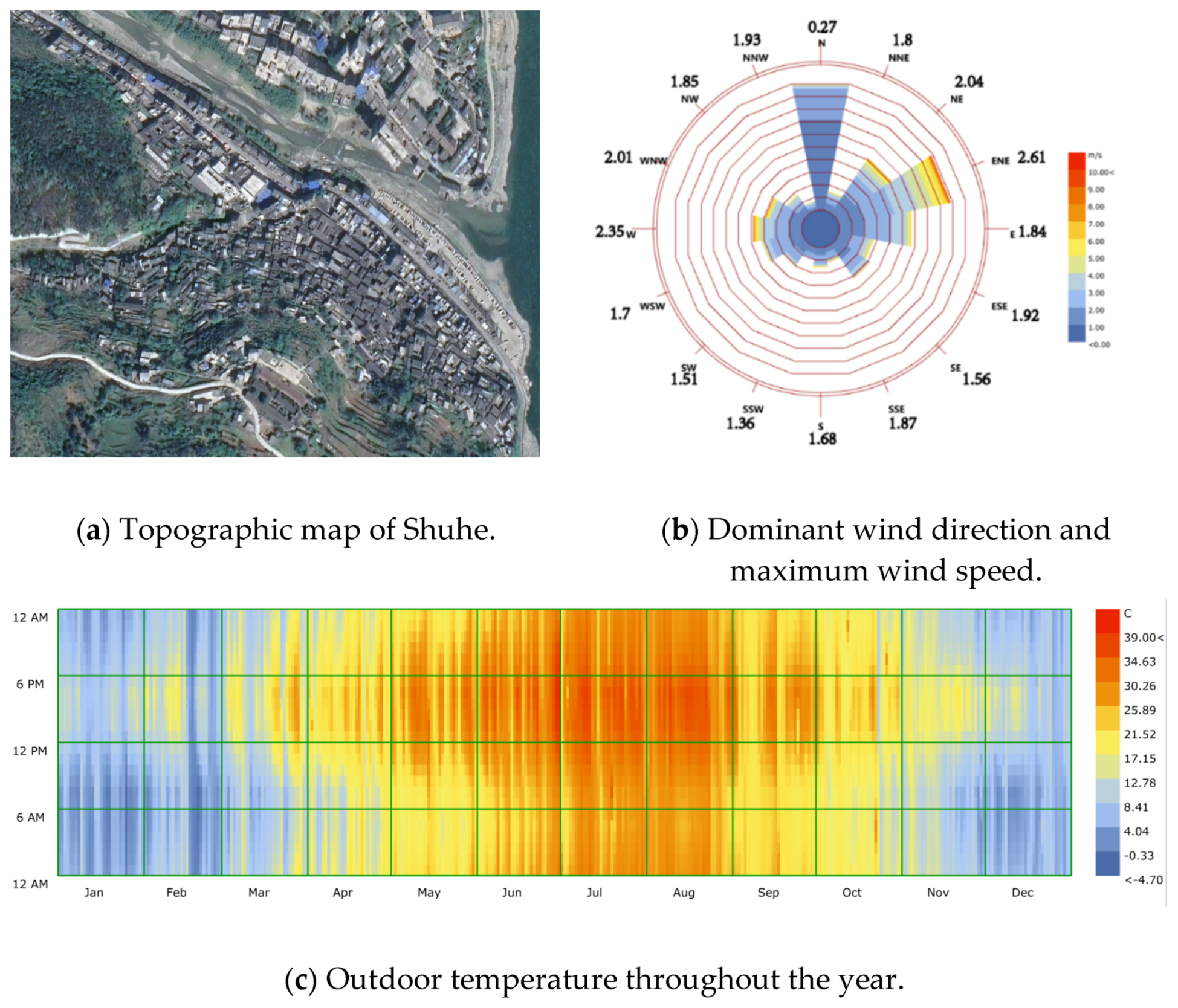
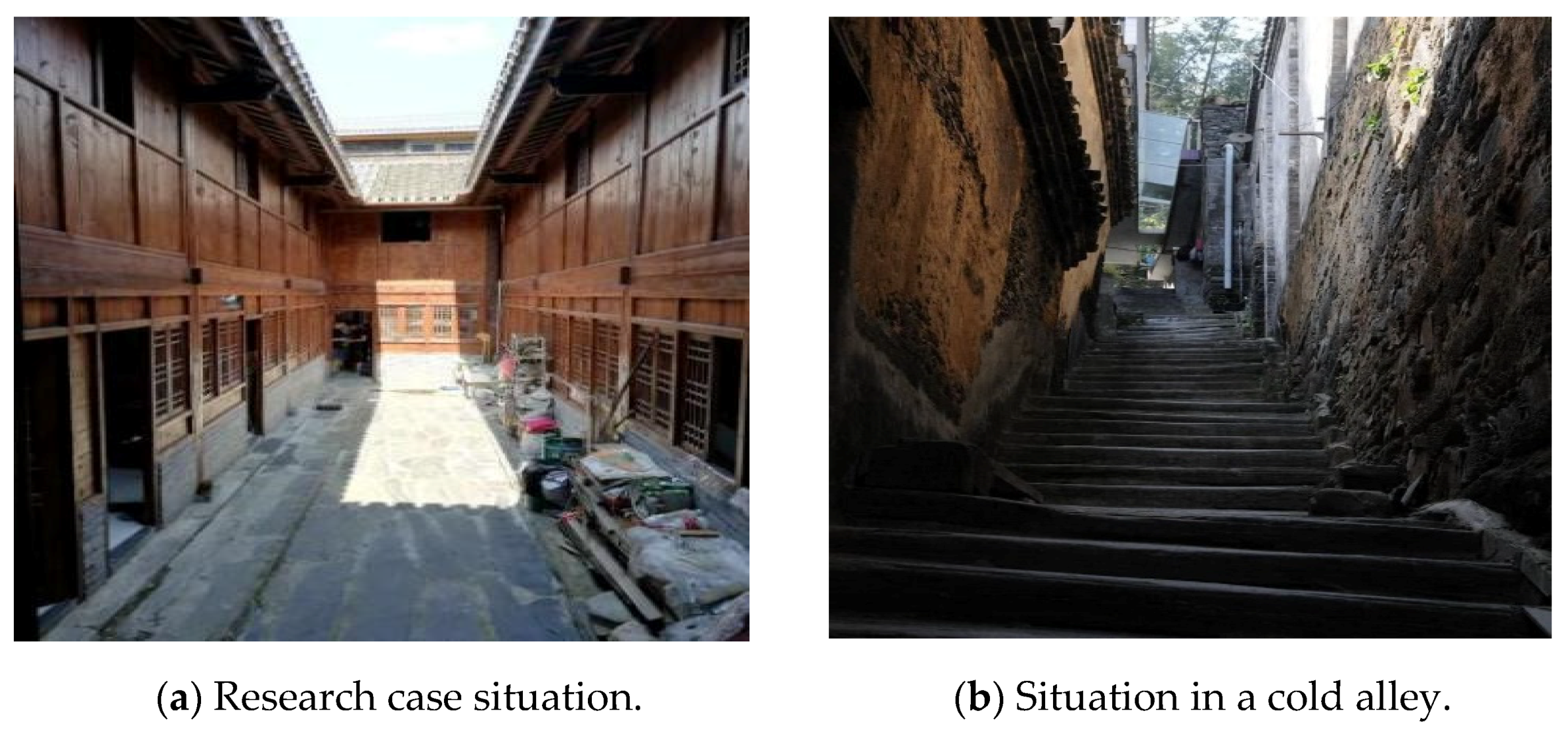
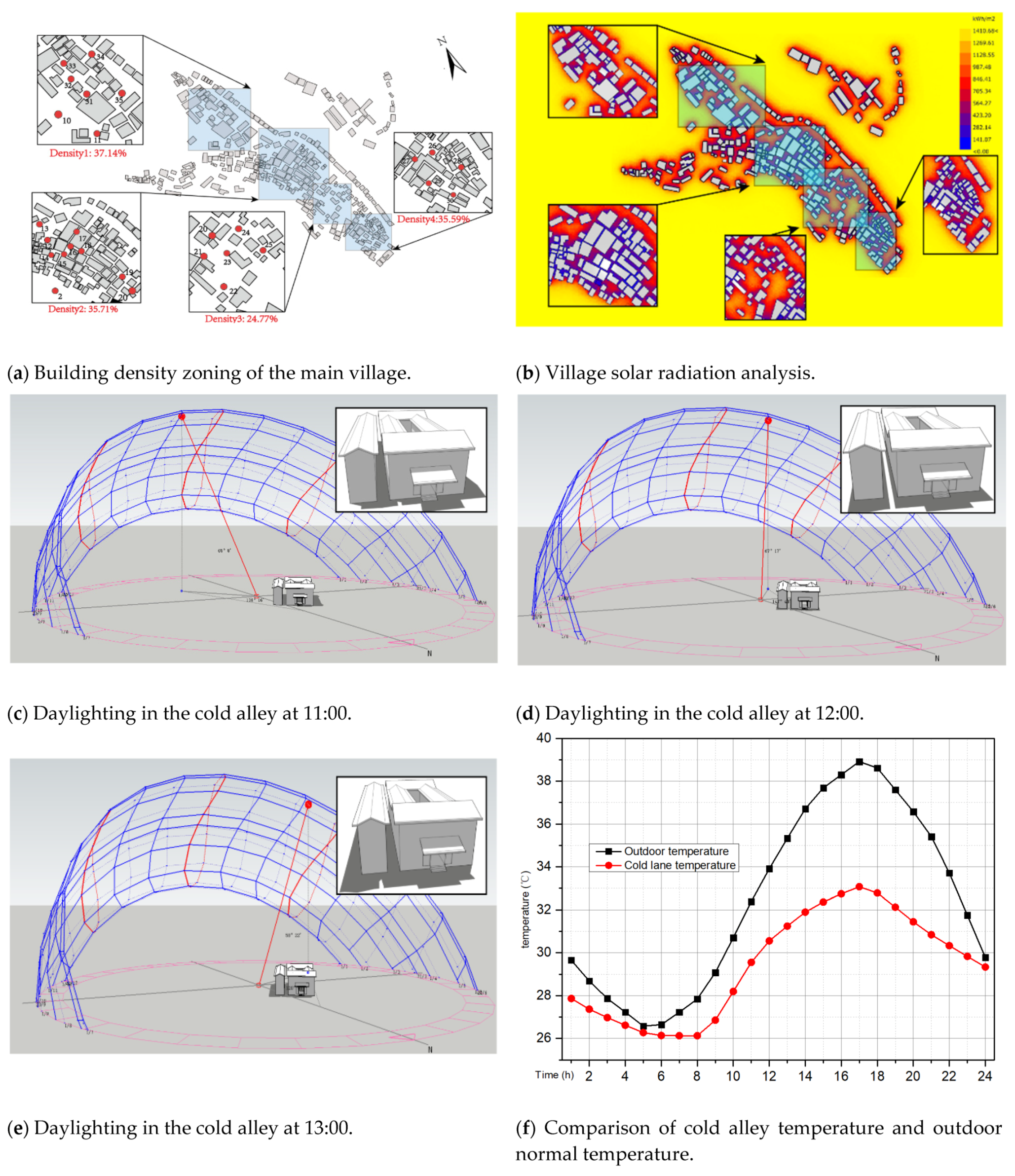

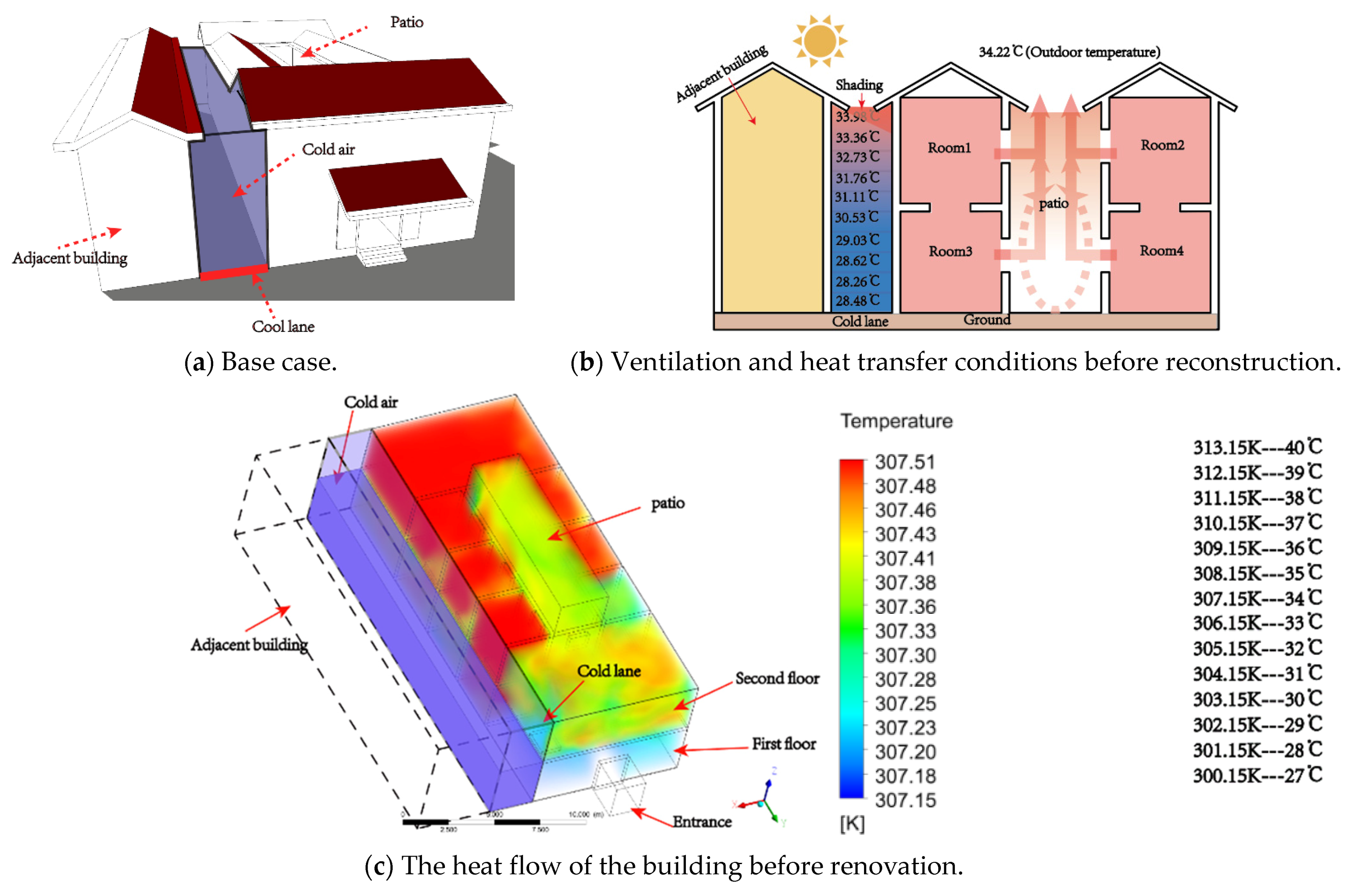
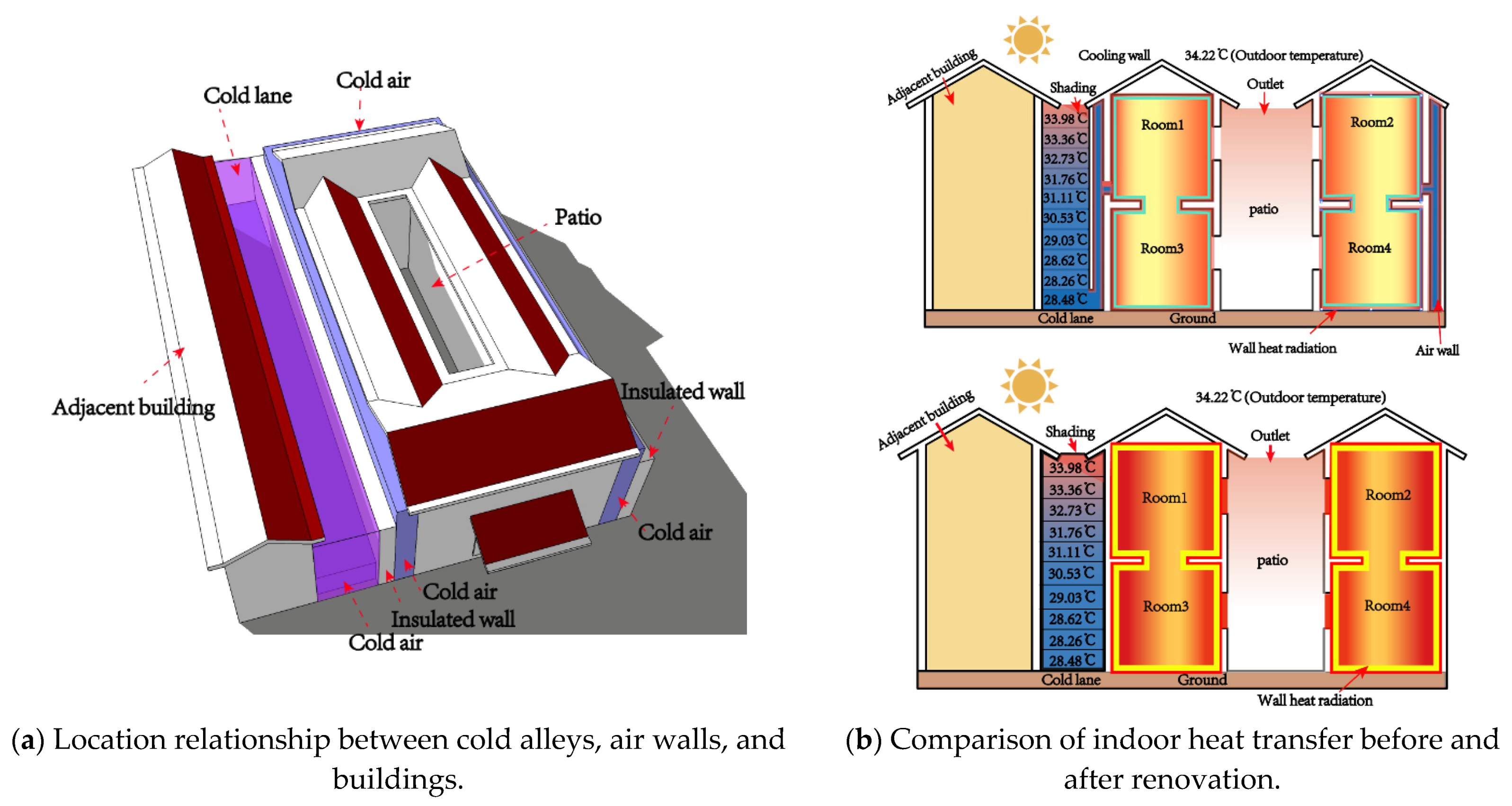
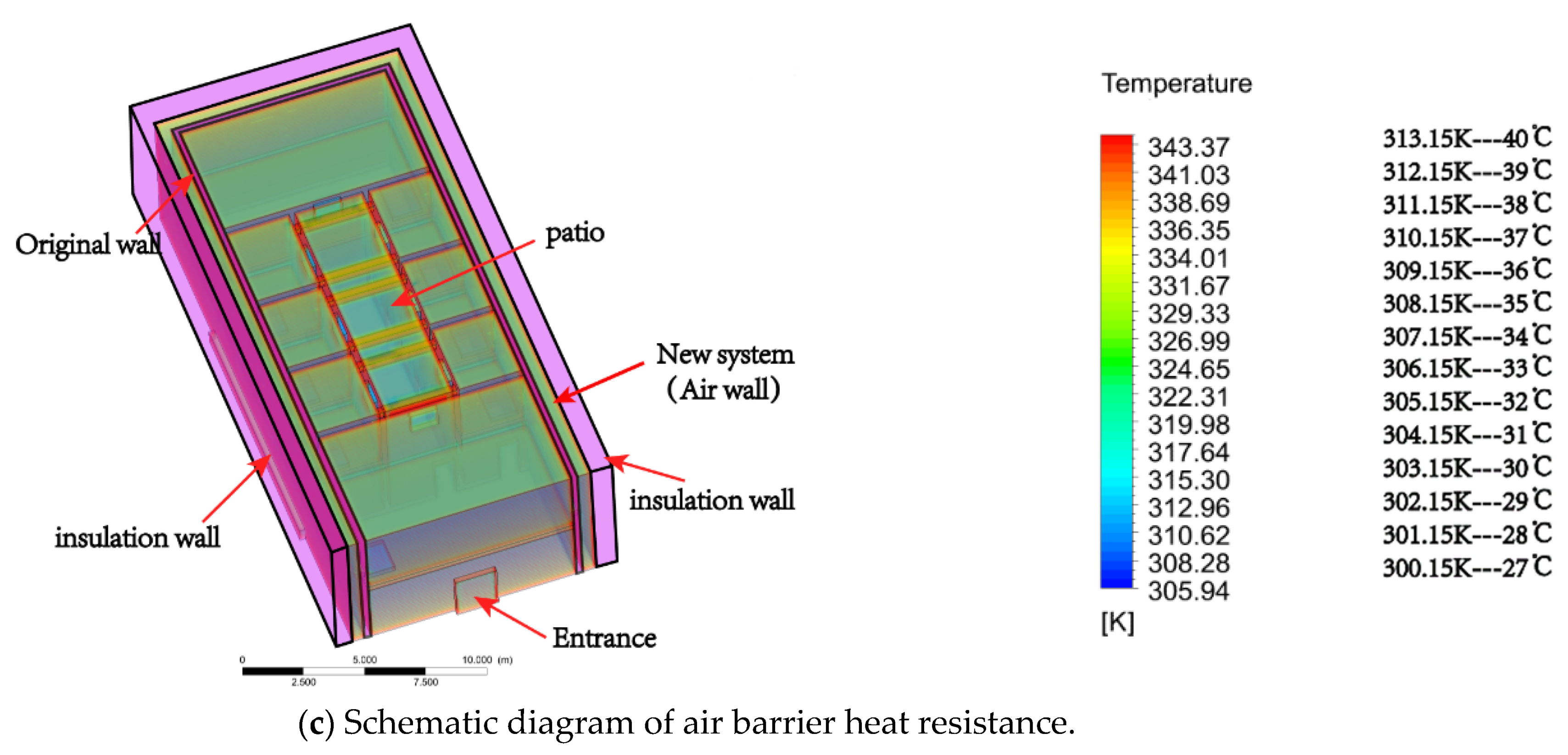
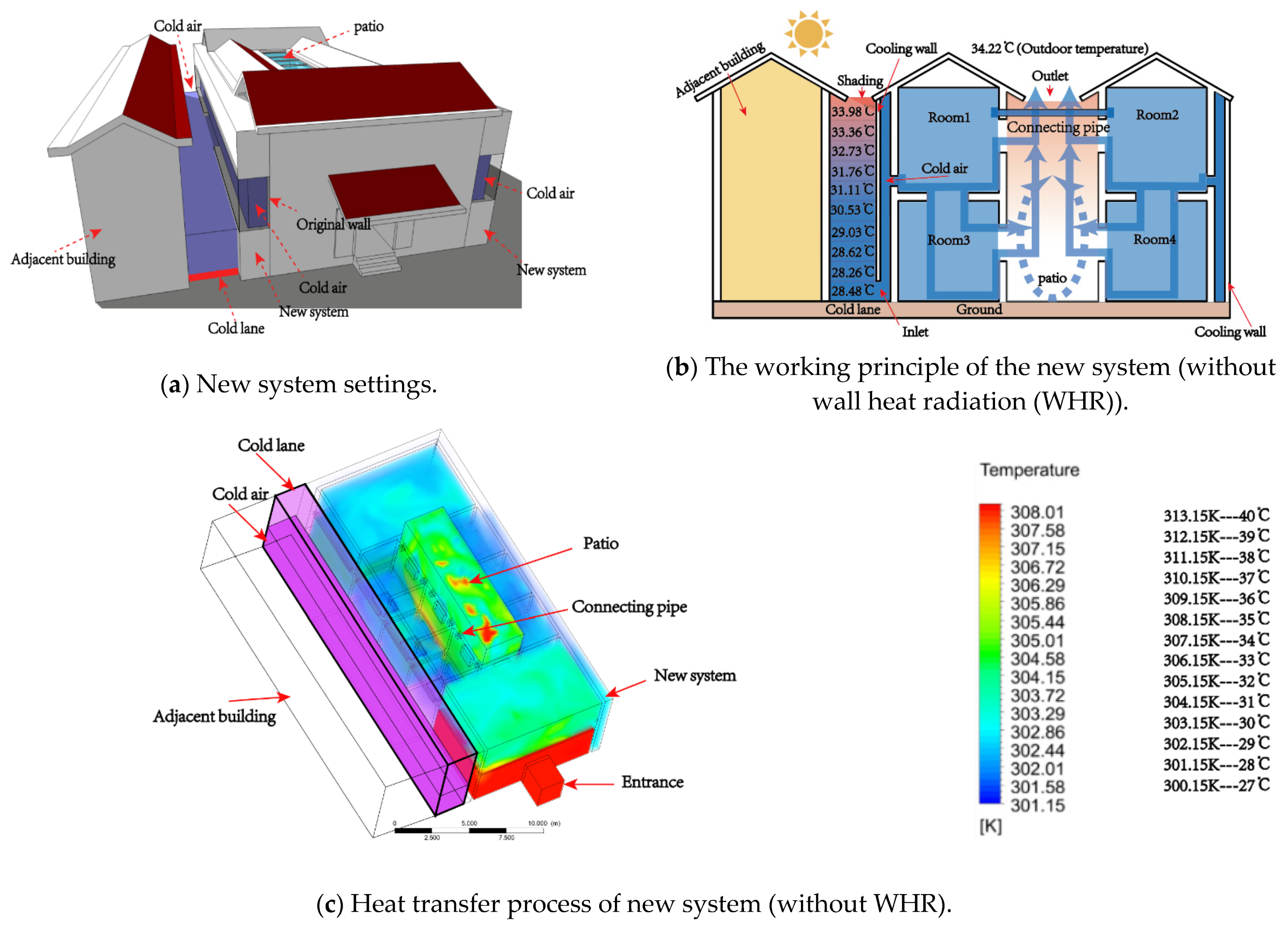
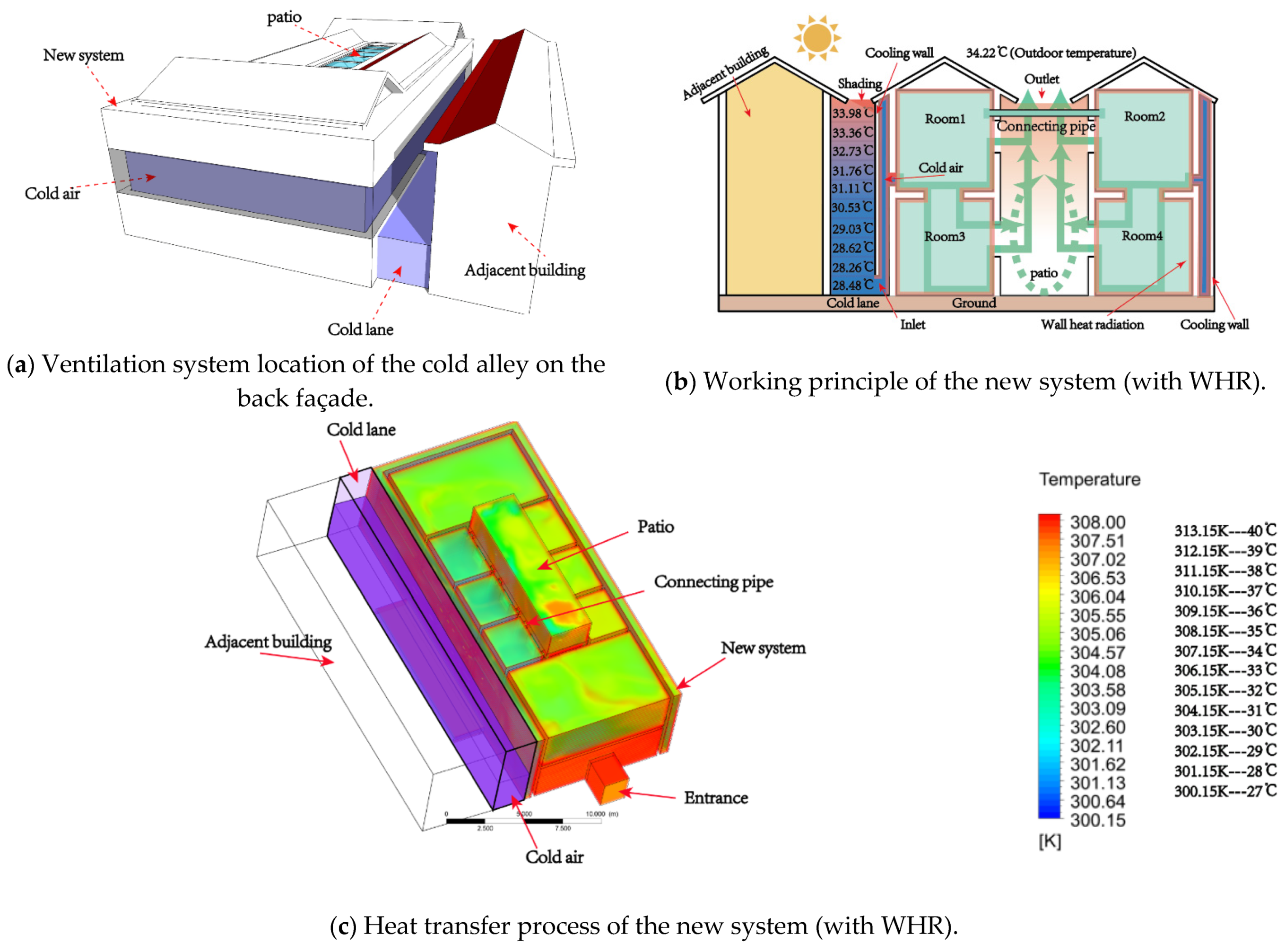
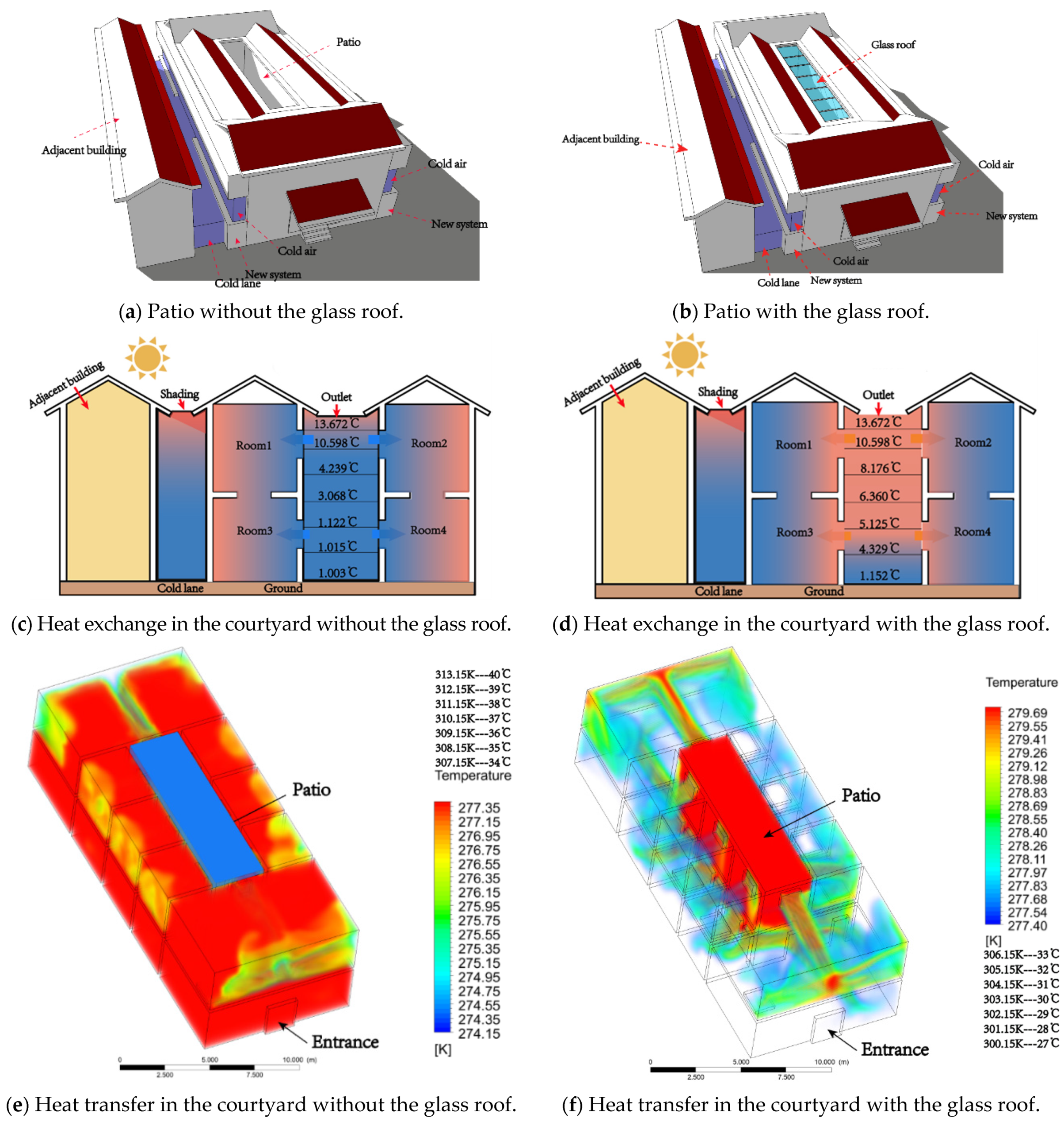
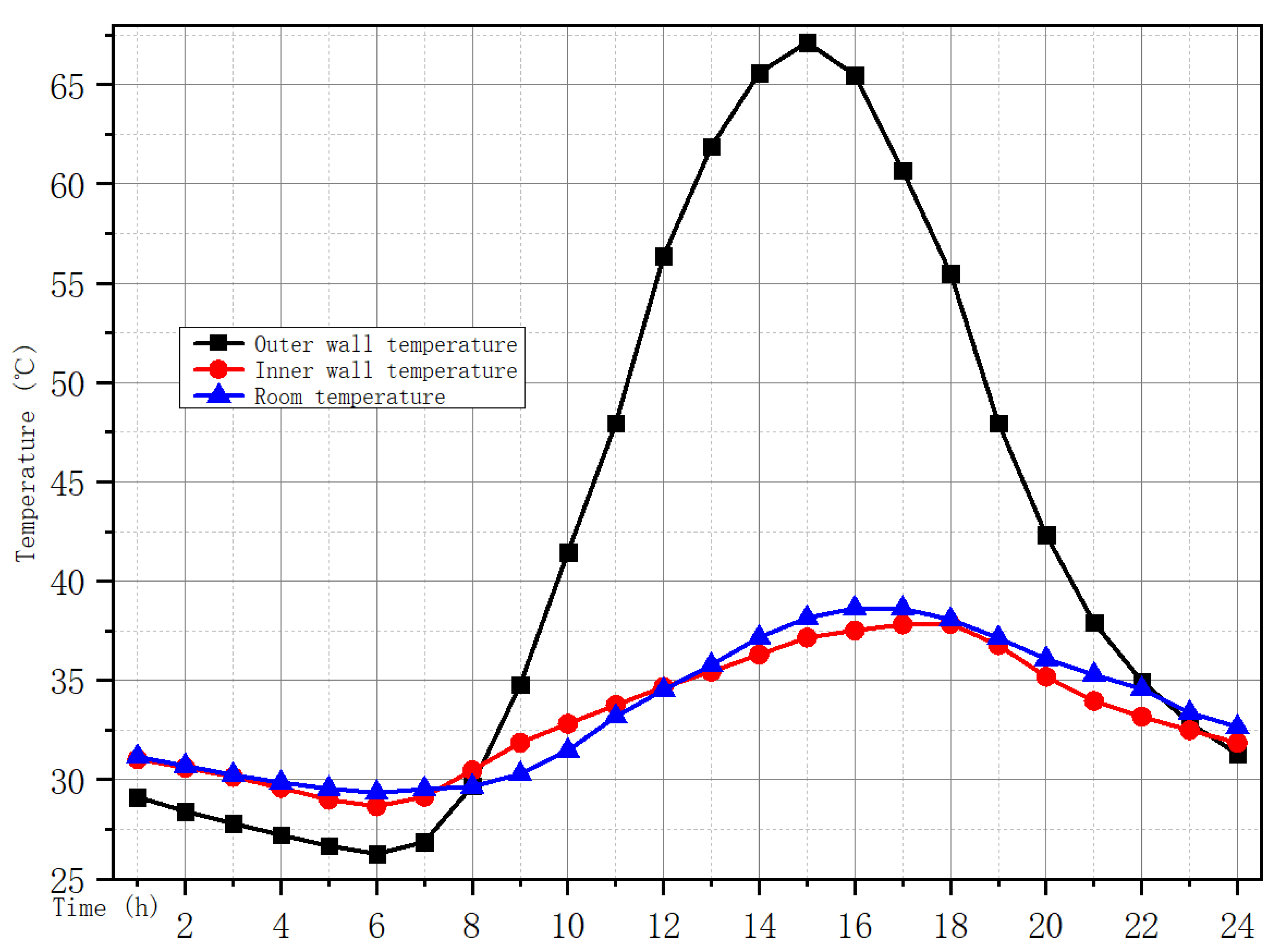
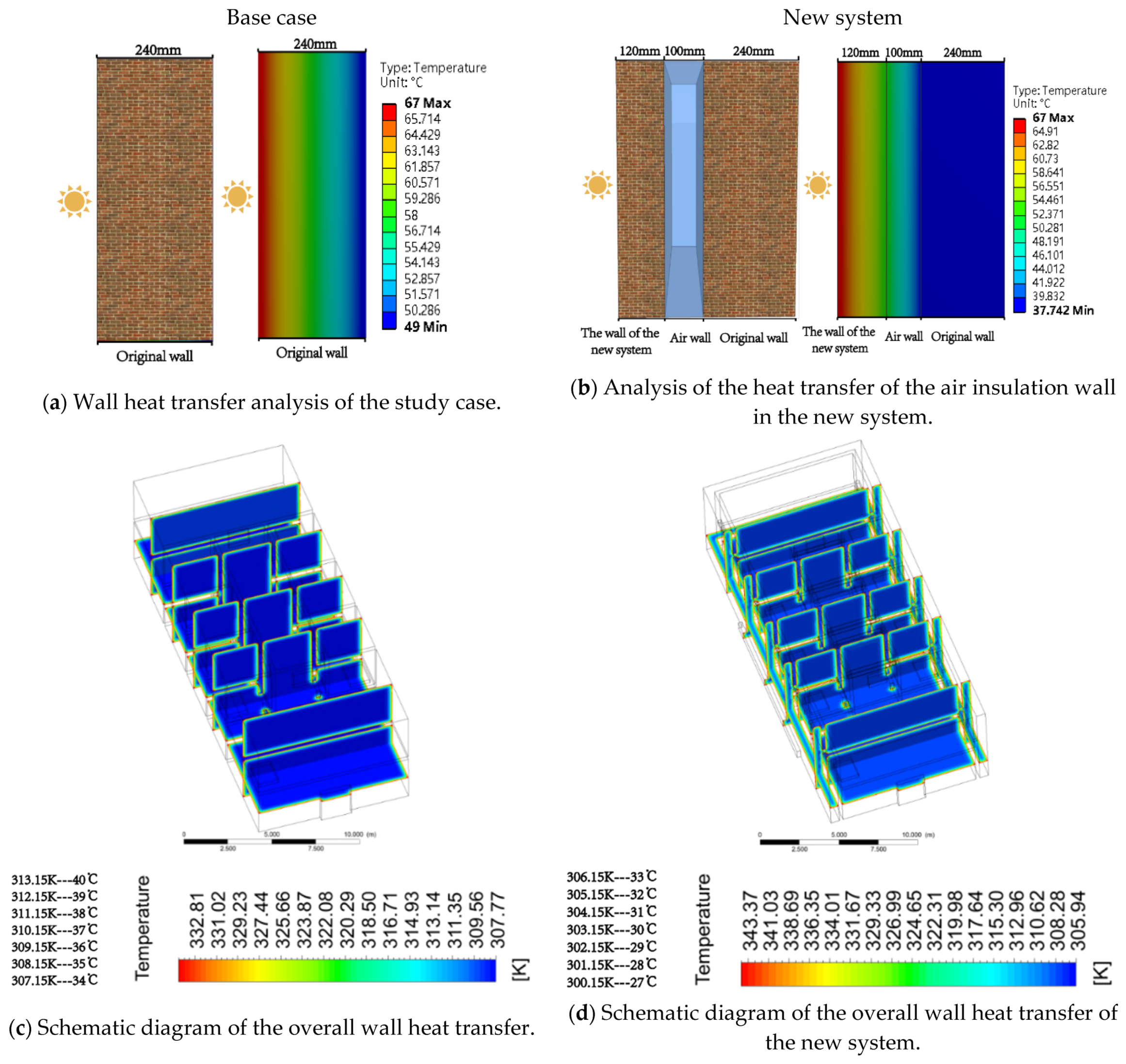
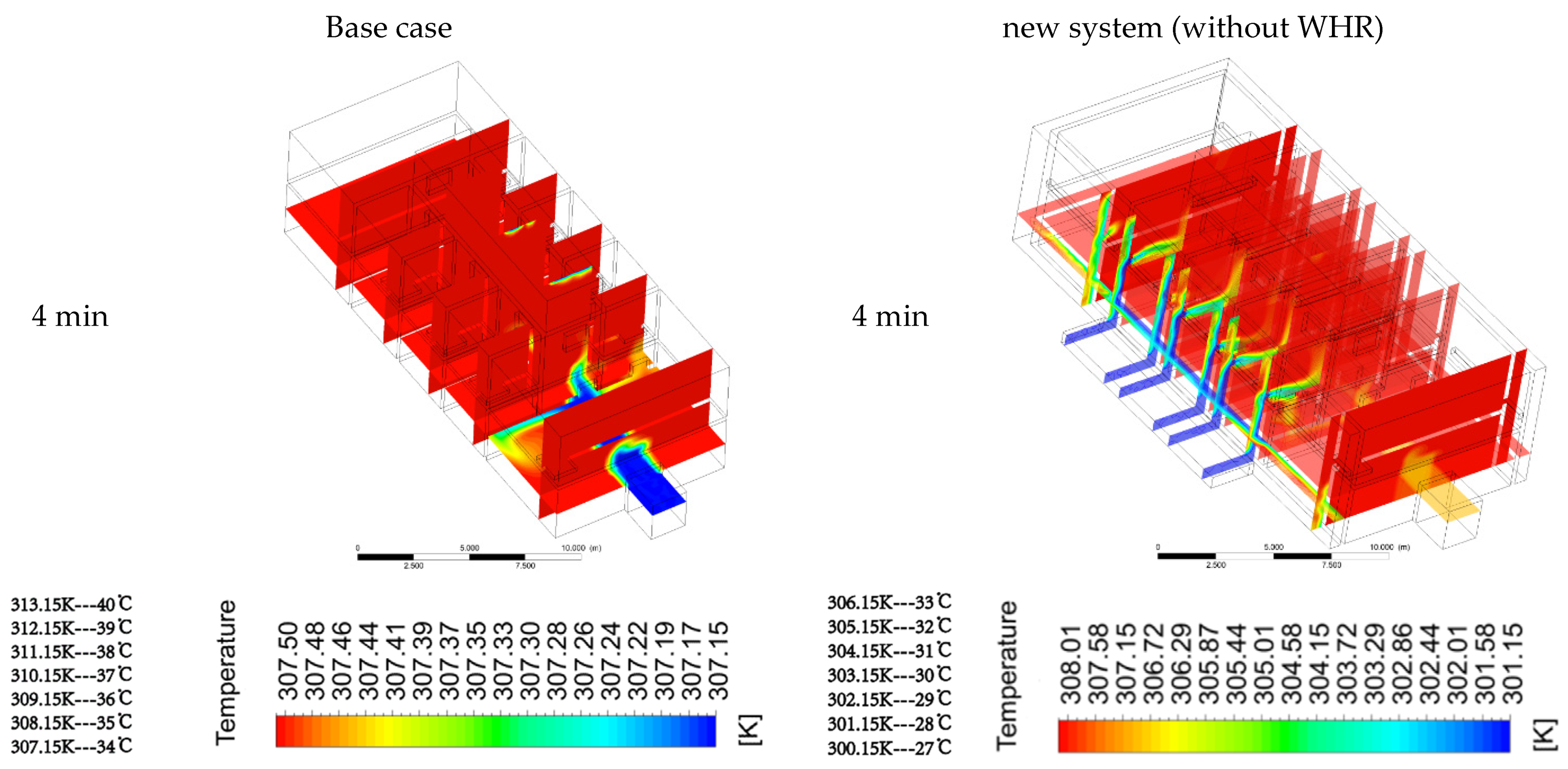
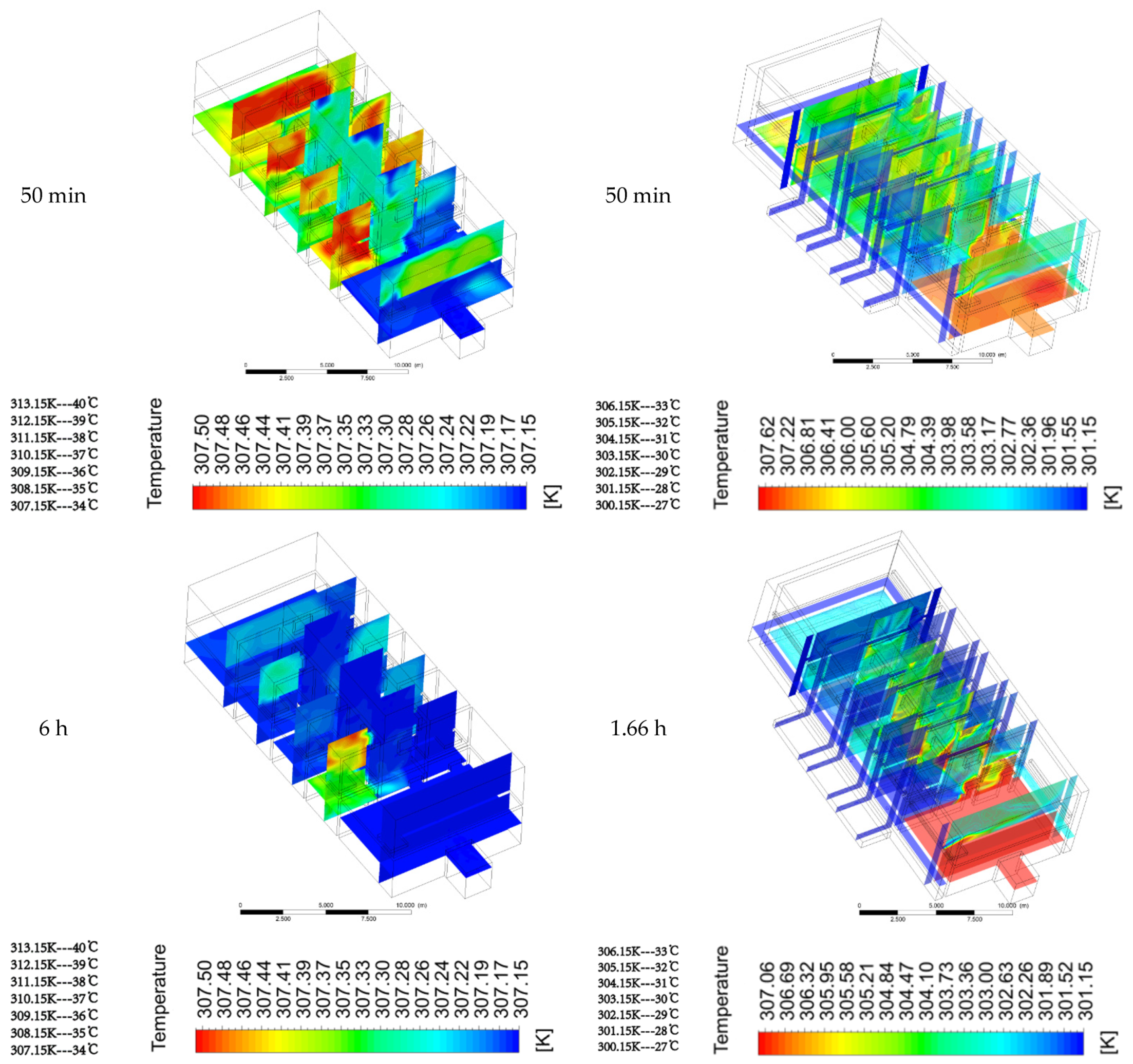
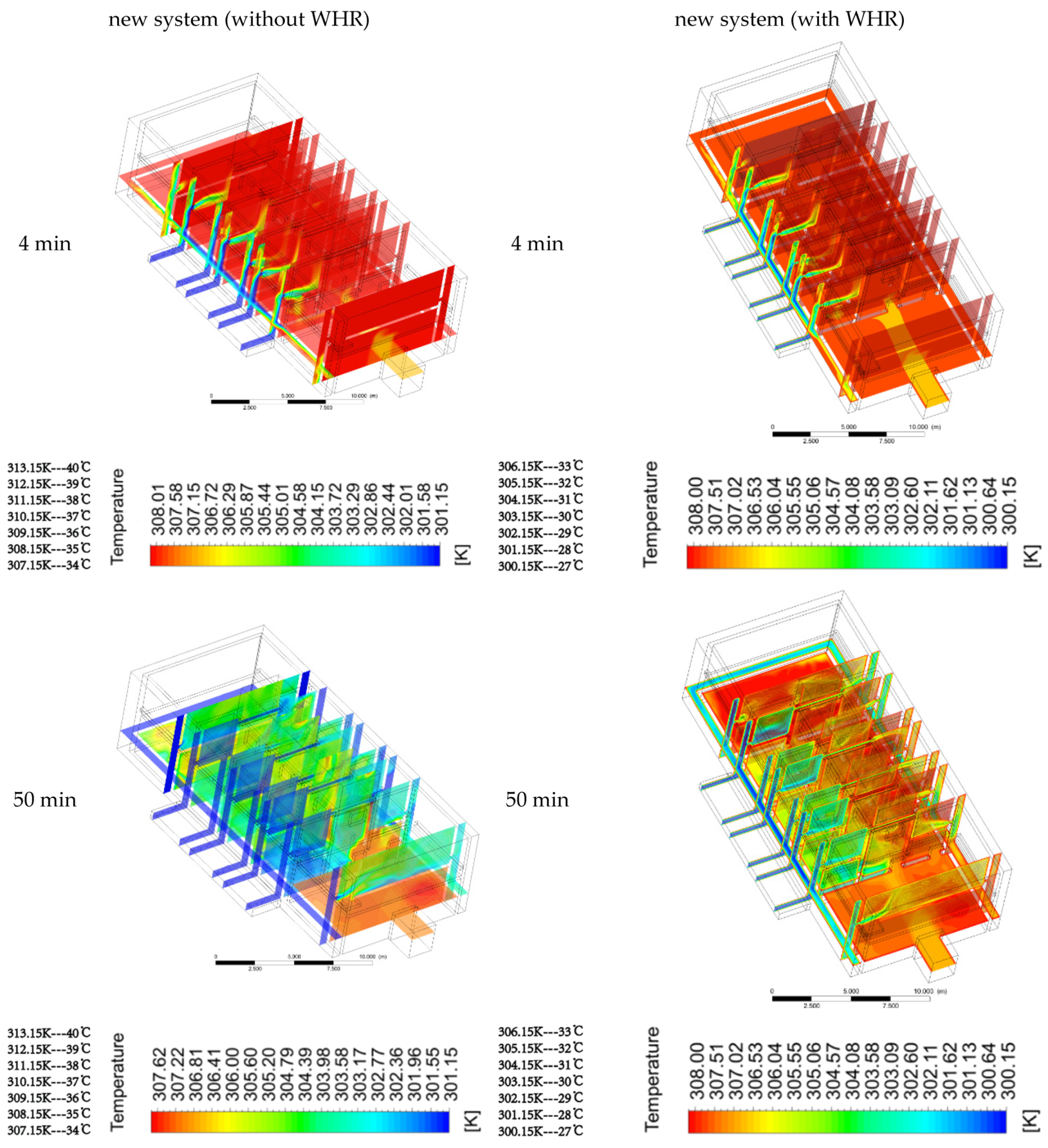
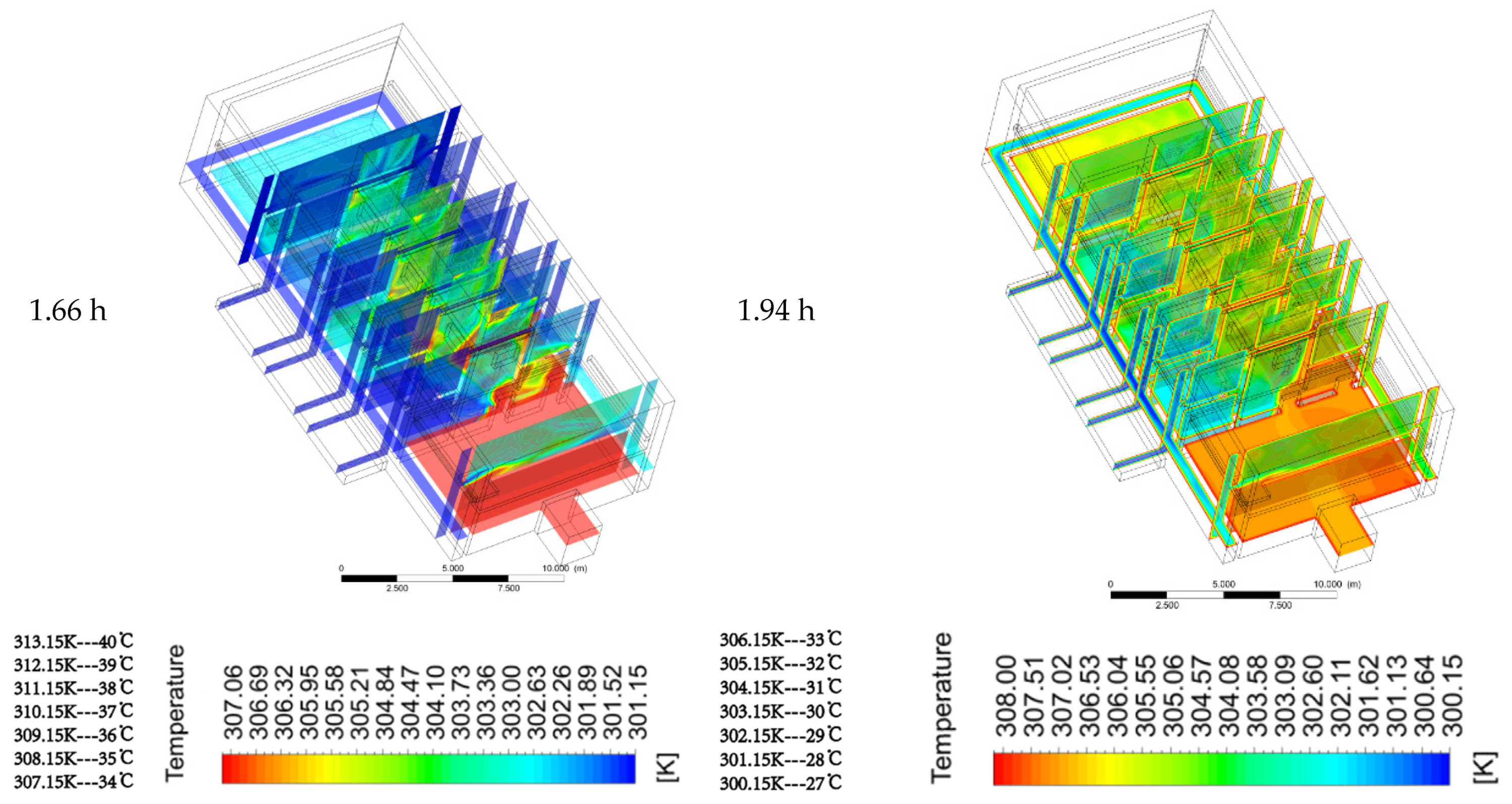


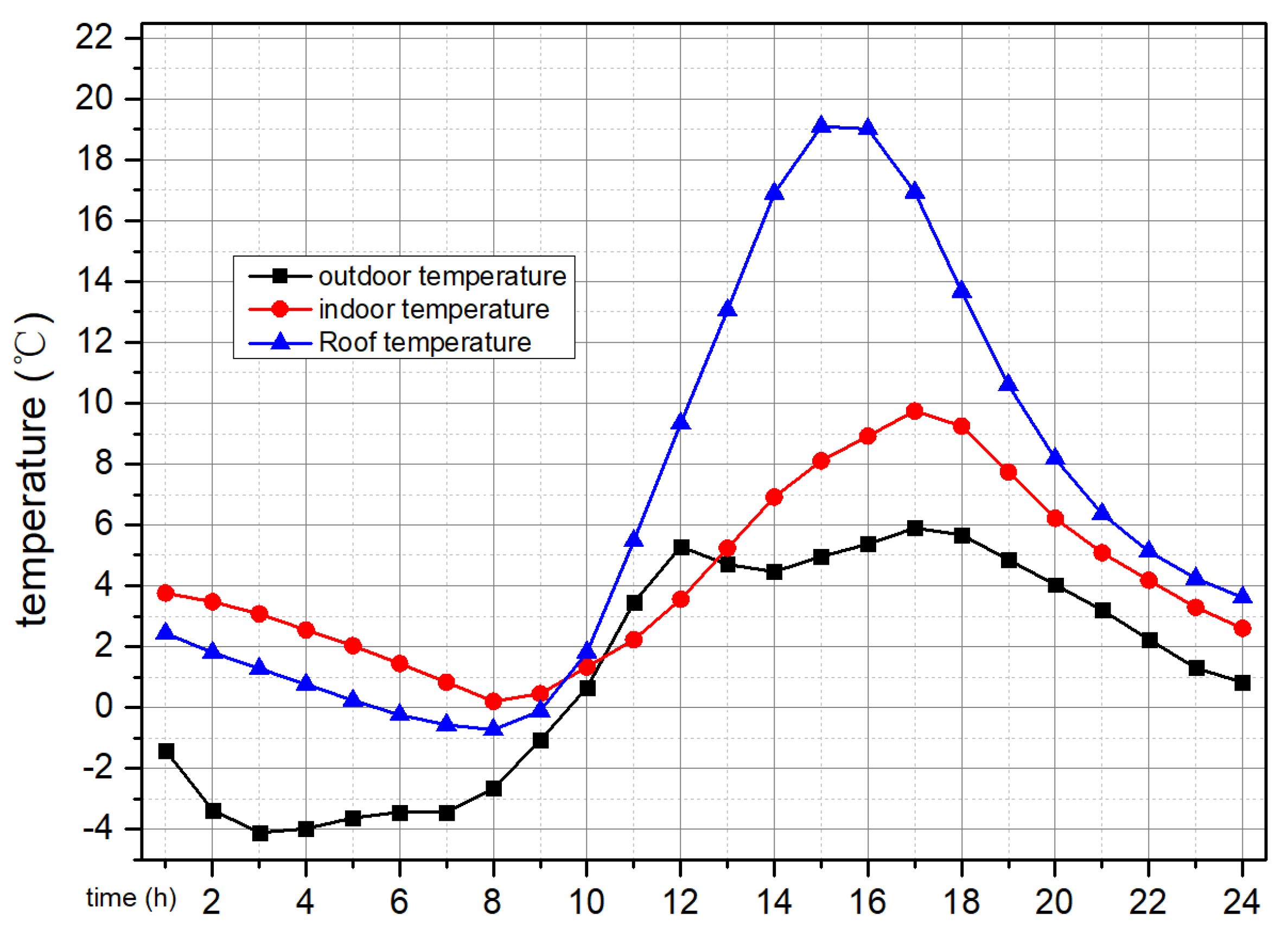


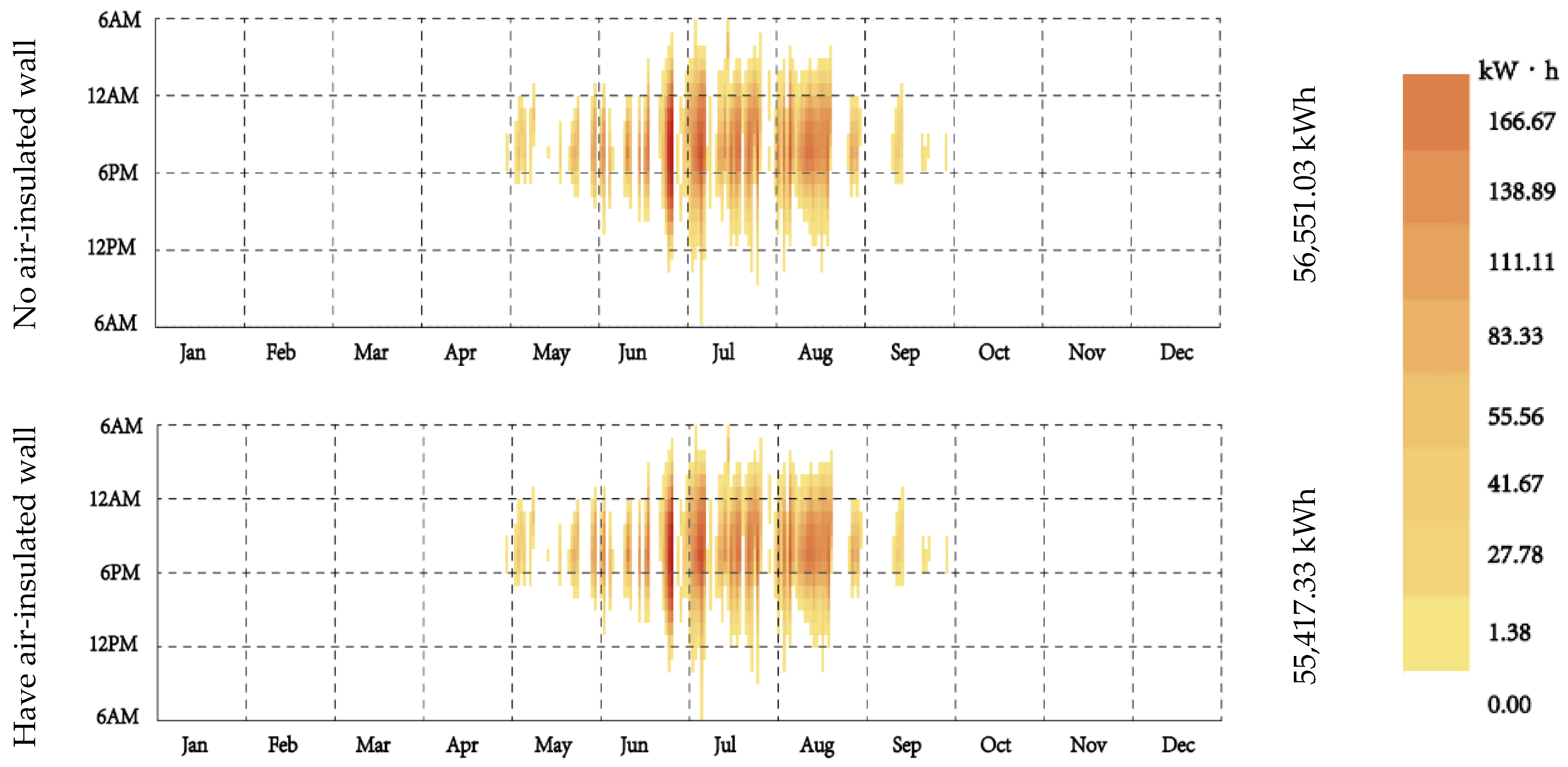


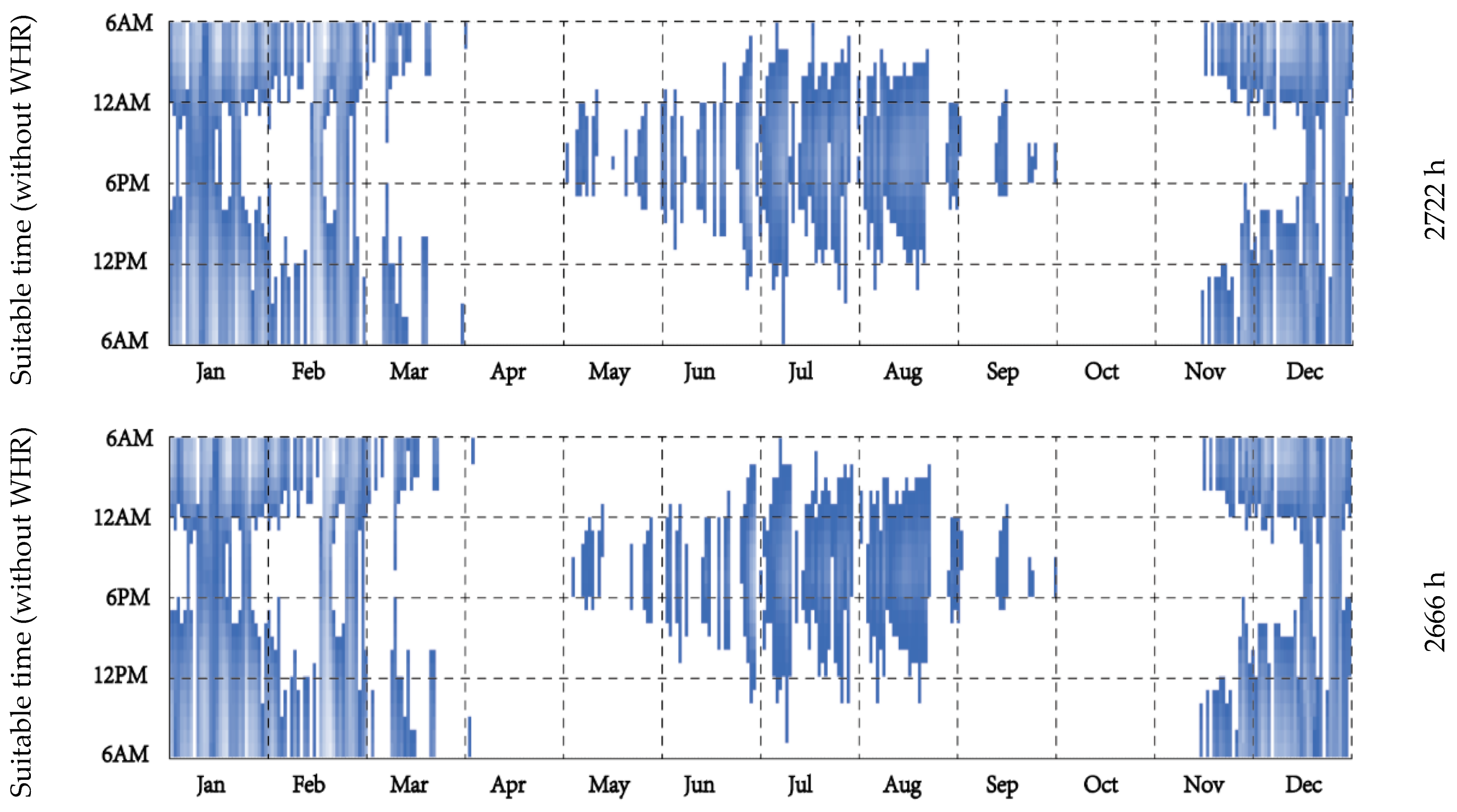

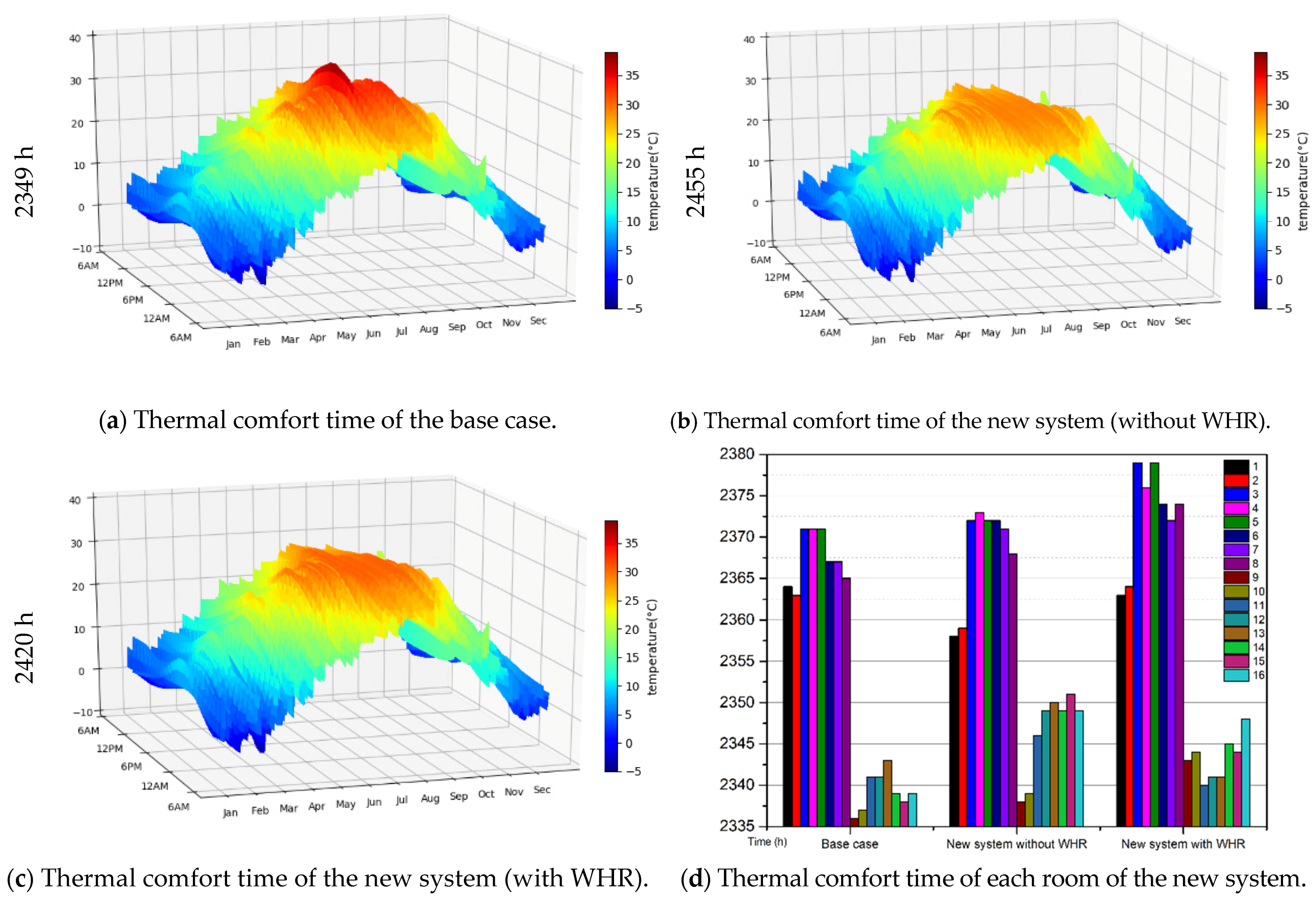
Publisher’s Note: MDPI stays neutral with regard to jurisdictional claims in published maps and institutional affiliations. |
© 2021 by the authors. Licensee MDPI, Basel, Switzerland. This article is an open access article distributed under the terms and conditions of the Creative Commons Attribution (CC BY) license (https://creativecommons.org/licenses/by/4.0/).
Share and Cite
Yao, X.; Han, S.; Dewancker, B.J. Study on the Combined Effect of Multiple Passive Energy-Saving Methods for Rural Houses with Cold Alleys. Appl. Sci. 2021, 11, 5636. https://doi.org/10.3390/app11125636
Yao X, Han S, Dewancker BJ. Study on the Combined Effect of Multiple Passive Energy-Saving Methods for Rural Houses with Cold Alleys. Applied Sciences. 2021; 11(12):5636. https://doi.org/10.3390/app11125636
Chicago/Turabian StyleYao, Xingbo, Shuo Han, and Bart Julien Dewancker. 2021. "Study on the Combined Effect of Multiple Passive Energy-Saving Methods for Rural Houses with Cold Alleys" Applied Sciences 11, no. 12: 5636. https://doi.org/10.3390/app11125636
APA StyleYao, X., Han, S., & Dewancker, B. J. (2021). Study on the Combined Effect of Multiple Passive Energy-Saving Methods for Rural Houses with Cold Alleys. Applied Sciences, 11(12), 5636. https://doi.org/10.3390/app11125636





